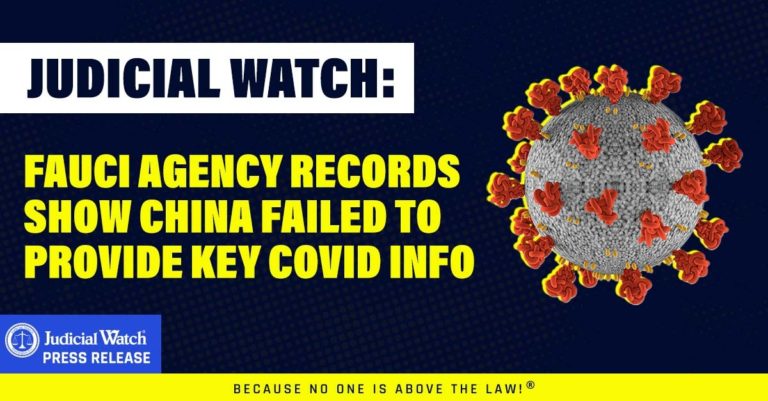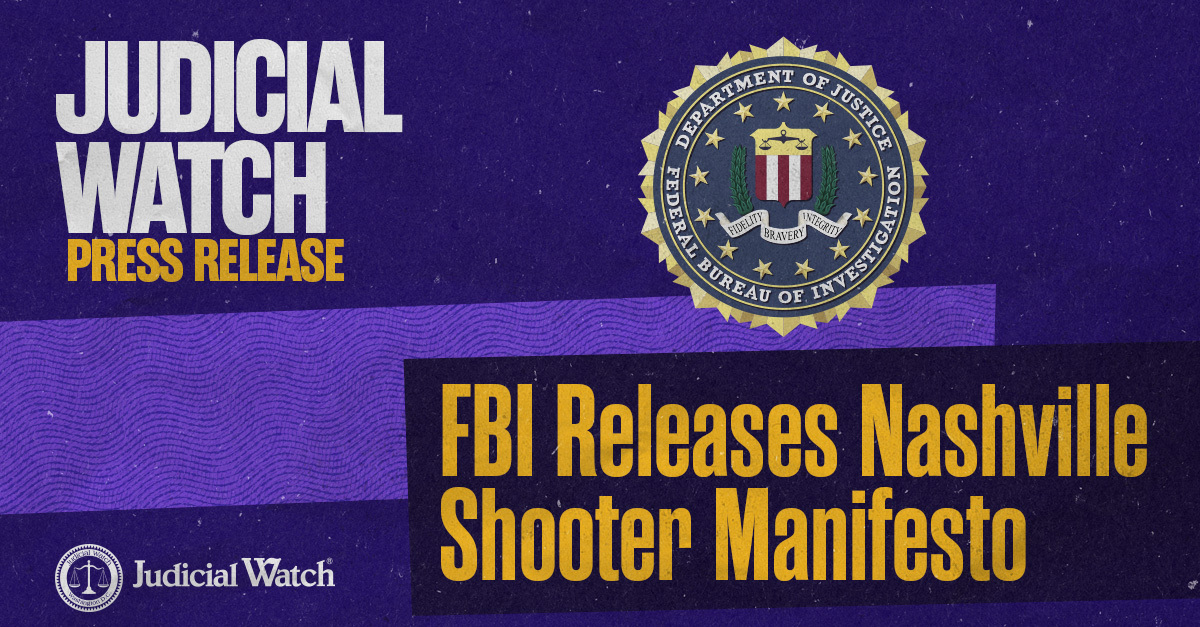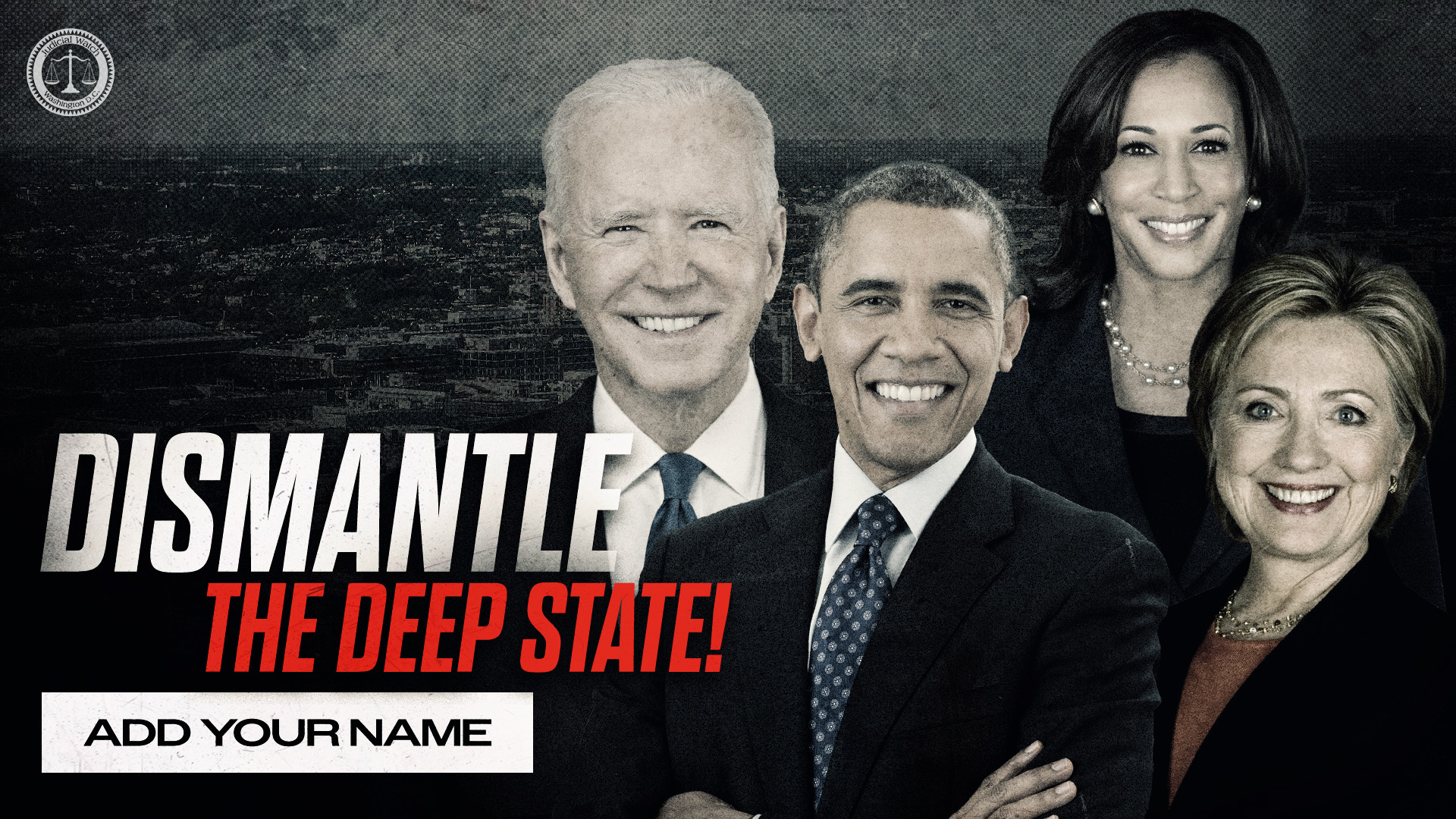
Judicial Watch: Fauci Agency Records Show China Failed to Provide Key COVID Info

(Washington, DC) – Judicial Watch announced today that it received 90 pages of records from the Department of Health and Human Services (HHS) that show the State Department and Dr. Anthony Fauci’s agency, the U.S. National Institute of Allergy and Infectious Diseases (NIAID), knew immediately in January 2020 that China was withholding COVID data, which was hindering risk assessment and response by public health officials.
The records also show that, nearly two years before the coronavirus outbreak, the U.S. National Institutes of Health (NIH) sent “experts” from the NIH-supported P4 lab at the University of Texas Medical Branch to train Wuhan Institute of Virology lab technicians in lab management and maintenance due to the Wuhan lab’s shortage of trained staff. The same April 2018 cable noted that an official from EcoHealth Alliance “plans to visit Wuhan to meet with Shi [Zhengli],”
The records were obtained by Judicial Watch through a Freedom of Information Act (FOIA) lawsuit for records of communications, contracts and agreements with the Wuhan Institute of Virology (Judicial Watch, Inc. v. U.S. Department of Health and Human Services (No. 1:21-cv-00696)). The lawsuit specifically sought records about NIH grants that benefitted the Wuhan Institute of Virology.
The novel coronavirus outbreak began in Wuhan, China, in December 2019.
After the outbreak, on January 8, 2020, Dr. Ping Chen, who had been NIAID’s top official in China, emails senior NIAID colleagues Gray Handley, Erik Stemmy, Gayle Bernabe, and Barney Graham with the subject line “PRC Response to Pneumonia Cases Shows Increased Transparency Over Past Outbreaks, but Gaps in Epidemiological Data Remain.” Chen writes:
hi, here is the cable from US Embassy Beijing reporting on the pneumonia outbreak in Wuhan, China. It has ruled out SARS, MERS, and flu. [Redacted] confirmed it is viral infection. [Redacted] The cable contains SBU information. So please don’t distribute it widely.
The summary of the cable states:
While PRC officials have released timely and open general information about the outbreak, a lack of epidemiologic data – including an ‘epi curve’ (a summary of dates of onset of illness), characteristics of infected individuals, and other basic epidemiologic information – hinders better risk assessment and response by public health officials. Authorities have also not released information on how they are defining a “case.” Given these gaps in detailed information to-date, and lack of a final confirmed pathogen, the risk to the United States and global health is difficult to assess at this time.
***
As of January 7, the Wuhan Health Commission has reported 59 local cases of pneumonia with unknown cause. (Note: Wuhan, a city of approximately 11 million people, is the capital of Central China’s Hubei Province. End note.) According to the Health Commission, some patients are vendors who work in the Huanan Seafood Market, which also sells live exotic animals, including beaver, snakes, porcupines, and deer.
***
Health officials state there has been no confirmed human-to-human transmission of the disease, and no cases among health workers. Laboratory investigations have ruled out influenza, avian influenza, SARS, MERS, and other common respiratory pathogens, and are awaiting final pathogen results.
***
PRC [People’s Republic of China] officials on December 31, 2019 alerted WHO to the pneumonia outbreak. WHO contacts told Embassy officials that PRC health departments continue to provide information about the outbreak in accordance with WHO’s International Health Regulations (IRR). While China has been forthcoming with standard information, WHO contacts note they have not received more detailed and potentially useful information, such as “epi curves” or other epidemiological data. The flow of official PRC information on this outbreak is limited to that coming from the Wuhan Health Commission and National Health Commission.
On January 30, 2020, Chen forwards to senior NIAID colleagues Gray Handley, Gayle Bernabe, Joyelle Dominique, William Rosa, Tami Lu and Hilary Marsten a cable issued by the U.S. Embassy in Beijing, which provides a detailed situation report on Chinese government responses to the then-fast spreading SARS-CoV-2 virus from across the country. The cable discusses Chinese virus mitigation measures, infection case numbers, travel restrictions, and quarantine measures then taking place in Beijing, Chengdu, Guangzhou, Shanghai, and Shenyang.
In a section discussing “Media/Social Media” reporting on the virus in China, the cable discusses a Global Times article about the “detention” in early January 2020 of eight Chinese residents for spreading “rumors” about the outbreak of the virus.
[An] article in Global Times praised Wuhan residents for “whistle-blowing” on virus outbreak. A top epidemiologist at the Chinese Center for Disease Control and Prevention (CCDC) on Wednesday commended eight residents, who were detained in early January for spreading “rumors” about the outbreak of the novel coronavirus. Zeng Guang, Chief epidemiologist at the CCDC, said those eight residents should be highly regarded as they turned out to be correct about the viral outbreak, even though the information they spread “lacked scientific evidence.” Zeng’s comment followed an article from the Supreme People’s Court of China (SPC) on Tuesday, in which the top court said that the eight Wuhan residents should be “tolerated” and their act of spreading the information, if taken seriously, would have done much good to the public.
On April 15, 2020, an official whose name is redacted sends an email to colleagues labeled “WIV [Wuhan Institute of Virology] Cables,” and writes, “As I am sure you are quite aware at this point the cables ESTH [State Department’s Environment, Science, Technology and Health Section] wrote on the WIV lab and the concerns we had about the findings of the papers on bat coronavirus research have become big news lately.”
An official forwards an email exchange from April 12, 2018, labeled “For your review – Cable on Wuhan Institute of Virology visit.” That email attached a cable titled “China Virus Institute Welcomes More U.S. Cooperation on Global Health Security.” The partially redacted summary of the cable begins:
China’s Wuhan Institute of Virology, a global leader of virus research, is a key partner for the United States in protecting global health security. Its role as operator of the just-launched ‘P4’ lab – the first such lab in China – opens up even more opportunities for expert exchange, especially in light of the lab’s shortage of trained staff.
The cable also mentions that there is also a “U.S. Centers for Disease Control (CDC)-supported [P4 lab] facility in Pune, India,” and that China “plans to stand up a second P4 lab in Harbin.” Harbin is the capital of Heilongjiang province in northeastern China.
The cable notes that Chinese officials, “described the [Wuhan] lab as a ’regional node’ in the global biosafety system and said it would play an emergency response role in an epidemic or pandemic.” It continues, “[E]xperts from the NIH-supported P4 lab at the University of Texas Medical Branch have trained Wuhan lab technicians in lab management and maintenance, institute officials said.” It went on, “NIH was a major funder, along with China’s National Science Foundation, of SARS research by the Wuhan Institute of Virology’s [redacted].” Finally, the cable notes, “[Redacted] with the EcoHealth Alliance (a New York City-based NGO that is working with the University of California Davis to manage the [redacted], plans to visit Wuhan to meet with Shi [Zhengli].”
Well prior to the outbreak, on October 2, 2017, NIAID Associate Director Gray Handley forwardsto colleagues a State Department cable titled “China’s Interest in the Global Virome Project Presents an Opportunity for Global Health Cooperation,” which another official notes “seems relevant to biobanking, IP [likely Intellectual Property], pandemic flu, and a bunch of other issue areas.”
The summary of the cable begins:
The proposed Global Virome Project (GVP), an international non-governmental organization built on a decade-long prototype initiated by the U.S. Agency for International Development (USAID), seeks to address vulnerability from emerging diseases by creating a global database of viruses of animal origin and identifying those pathogens with greatest potential to jump to humans through sequencing their genomes, understanding the ecology involved in transmission, and assessing risk to humans. This knowledge could then be used to devise treatments and countermeasures.
The cable states: “U.S-China collaboration on the Global Virome Project in an opportunity to lead innovation in science, collaborate with China, and potentially contribute to scientific breakthroughs.”
The records include a February 23, 2018, email between the U.S. Embassy in Beijing and NIH headquarters, in which NIH officials were monitoring “China Health News from Chinese Media through 02/23/2018:”
- Research at the Wuhan Institute of Virology into how bats “harbor highly pathogenic viruses like Ebola, Marburg and SARS coronavirus but do not show clinical signs of disease.”
- New Chinese discoveries that certain Traditional Chinese Medicines (TCM) could be used to combat bacterial and viral infections which Western medicines could not address due to growing antimicrobial resistance (AMR) to the Western drugs. They note, “Previous experiences showed than TCM remedies can be used as a substitute for Western antibiotics in the presence of some viral diseases, or lower the viral load” and that “further largescale clinical trials are needed before TCM antibiotics can be embraced and promoted globally.”
- A new nano-technology based flu vaccine the Chinese were developing at the Wuhan Institute of Virology.
- Chinese advances in “Human Gene Therapy”, in which “China is helping to advance gene and cell therapy and genome editing research by creating novel viral and nonviral vectors for gene delivery and innovative applications of CRISPR technology in a broad range of disease areas.”
“These FOIA documents show that Fauci’s agency has been hiding information on China’s failure to provide essential data on COVID-19,” said Judicial Watch President Tom Fitton. “The slow-rolling and stonewalling by Fauci’s agency on China, gain of function, and its COVID response generally is pure obstruction.”
Judicial Watch has been deeply involved in investigations into the origins of COVID-19 and has brought many facts to light.
In July 2021, Judicial Watch obtained records from NIAID officials in connection with the Wuhan Institute of Virology revealing significant collaborations and funding that began in 2014. The records revealed that NIAID gave nine China-related grants to EcoHealth Alliance to research coronavirus emergence in bats and was the NIH’s top issuer of grants to the Wuhan lab itself.
In June 2021, Judicial Watch obtained documents from HHS revealing that from 2014 to 2019, $826,277 was given to the Wuhan Institute of Virology for bat coronavirus research by the National Institute of Allergy and Infectious Diseases (NIAID), which is headed by Dr. Anthony Fauci.
In March 2021, Judicial Watch publicly released emails and other records of Dr. Anthony Fauci and Dr. H. Clifford Lane from HHS showing that National Institutes of Health (NIH) officials tailored confidentiality forms to China’s terms and that the World Health Organization (WHO) conducted an unreleased, “strictly confidential” COVID-19 epidemiological analysis in January 2020.
In October 2020, Judicial Watch uncovered emails showing a WHO entity pushing for a press release, approved by Dr. Fauci, “especially” supporting China’s COVID-19 response.
###
















